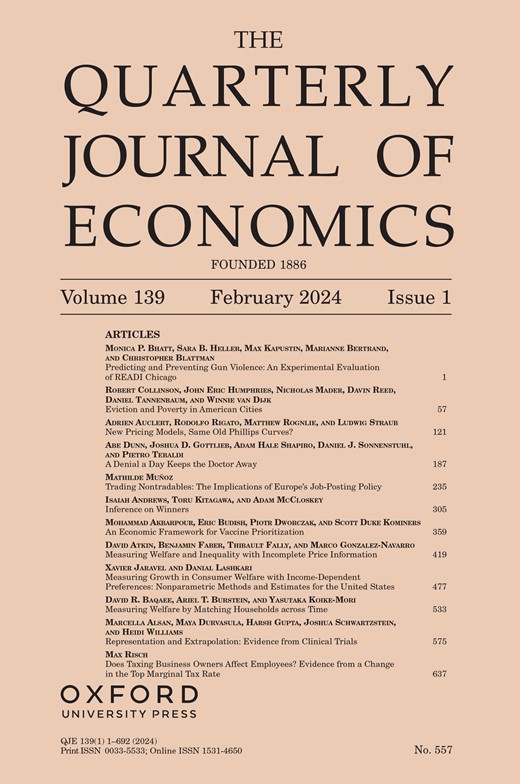最低工资与种族不平等*
IF 12.7
1区 经济学
Q1 ECONOMICS
引用次数: 90
摘要
20世纪60年代末和70年代初,美国白人和黑人工人的收入差距急剧下降。这篇文章表明,最低工资的扩大在这一下降中发挥了关键作用。1966年的《公平劳动标准法》将联邦最低工资覆盖范围扩大到农业、餐馆、疗养院和其他服务业,这些服务业以前没有被覆盖,近三分之一的黑人工人受雇于这些服务业。我们将劳工统计局行业工资报告中的1000多个小时工资分布数字化,并使用CPS微观数据来调查这项改革对工资、就业和种族不平等的影响。使用跨行业差异设计,我们发现新覆盖行业的工人收入大幅增长。对黑人工人的影响几乎是白人工人的两倍。在经过处理的行业中,经可观察性调整后的种族差距从之前的25个对数点下降到之后的0。我们可以排除黑人工人失业的严重影响。使用集群设计,我们没有发现改革对就业的总体影响。1967年最低工资的延长可以解释民权时代种族收入和收入差距缩小20%以上的原因。我们的研究结果为美国劳动力市场不平等的动态提供了新的线索,并表明最低工资政策可以在减少种族经济差异方面发挥关键作用。JEL代码:J38、J23、J15、J31本文章由计算机程序翻译,如有差异,请以英文原文为准。
Minimum Wages and Racial Inequality*
The earnings difference between white and black workers fell dramatically in the United States in the late 1960s and early 1970s. This article shows that the expansion of the minimum wage played a critical role in this decline. The 1966 Fair Labor Standards Act extended federal minimum wage coverage to agriculture, restaurants, nursing homes, and other services that were previously uncovered and where nearly a third of black workers were employed. We digitize over 1,000 hourly wage distributions from Bureau of Labor Statistics industry wage reports and use CPS microdata to investigate the effects of this reform on wages, employment, and racial inequality. Using a cross-industry difference-in-differences design, we show that earnings rose sharply for workers in the newly covered industries. The impact was nearly twice as large for black workers as for white workers. Within treated industries, the racial gap adjusted for observables fell from 25 log points prereform to 0 afterward. We can rule out significant disemployment effects for black workers. Using a bunching design, we find no aggregate effect of the reform on employment. The 1967 extension of the minimum wage can explain more than 20% of the reduction in the racial earnings and income gap during the civil rights era. Our findings shed new light on the dynamics of labor market inequality in the United States and suggest that minimum wage policy can play a critical role in reducing racial economic disparities. JEL Codes: J38, J23, J15, J31
求助全文
通过发布文献求助,成功后即可免费获取论文全文。
去求助
来源期刊

Quarterly Journal of Economics
ECONOMICS-
CiteScore
24.20
自引率
2.20%
发文量
42
期刊介绍:
The Quarterly Journal of Economics stands as the oldest professional journal of economics in the English language. Published under the editorial guidance of Harvard University's Department of Economics, it comprehensively covers all aspects of the field. Esteemed by professional and academic economists as well as students worldwide, QJE holds unparalleled value in the economic discourse.
 求助内容:
求助内容: 应助结果提醒方式:
应助结果提醒方式:


